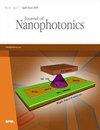Engineering of plasmonic electromagnetically induced transparency from double quantum dot-metal nanoparticle structure
IF 1.1
4区 物理与天体物理
Q4 NANOSCIENCE & NANOTECHNOLOGY
引用次数: 0
Abstract
Due to the limited study, this work engineers the parameters controlling the rate of absorbed energy from a double quantum dot (DQD)-metal nanoparticle (MNP) system at plasmonic electromagnetically induced transparency (PEIT) considering the strong coupling between DQD and MNP. The modeling is of the material property for which the energy states and transition momenta are calculated. The analysis considers the orthogonalized plane wave between the wetting layer (WL)-QD transitions. A huge (10−5 W) total absorption rate (Qtotal) from the system is attained. This result is higher by four orders and the power applied is less by three orders than that obtained in the literature. Many features are studied. Neglecting the WL, the system spectrum is similar to the left-handed picture of the system with WL. The value of Q depends on the situation of the QD energy states through the variation of the QD size, MNP radius, and distance separating the system. In the DQD-MNP hybrid system, the controlling factor that gives a high Qtotal in the PEIT case is the DQD combination with a weak probe and enough pump, i.e., the DQD structure works as a whole structure, not as two QDs working separately. Such a structure allows for manipulating the flexibility of carriers between DQD states that are not found in other structures. From the results, one can conclude that DQD behavior under the pump, probe, and single tunneling component produces two transparent windows. Adding a second tunneling component creates four transparency windows depending on the values of these applied parameters.双量子点-金属纳米粒子结构的等离子电磁诱导透明工程
由于研究有限,考虑到双量子点(DQD)和金属纳米粒子(MNP)之间的强耦合,本研究对控制双量子点(DQD)-金属纳米粒子(MNP)系统在等离子体电磁诱导透明(PEIT)时吸收能量速率的参数进行了设计。建模涉及材料特性,计算了材料的能态和转换矩。分析考虑了润湿层(WL)-QD 转换之间的正交平面波。系统的总吸收率(Qtotal)达到了巨大的(10-5 W)。与文献中的结果相比,这一结果高出四个数量级,而应用的功率则小了三个数量级。对许多特征进行了研究。在忽略 WL 的情况下,系统光谱与带 WL 系统的左手图相似。Q 值取决于 QD 能态的情况,即 QD 大小、MNP 半径和系统间距的变化。在 DQD-MNP 混合系统中,在 PEIT 情况下产生高 Qtotal 的控制因素是 DQD 与弱探针和足够泵的组合,即 DQD 结构作为一个整体结构工作,而不是作为两个 QD 单独工作。这种结构可以操纵 DQD 状态之间载流子的灵活性,这是其他结构所不具备的。从结果中可以得出结论:在泵浦、探针和单一隧道元件作用下,DQD 的行为产生了两个透明窗口。根据这些应用参数的值,添加第二个隧道分量可产生四个透明窗口。
本文章由计算机程序翻译,如有差异,请以英文原文为准。
求助全文
约1分钟内获得全文
求助全文
来源期刊

Journal of Nanophotonics
工程技术-光学
CiteScore
2.60
自引率
6.70%
发文量
42
审稿时长
3 months
期刊介绍:
The Journal of Nanophotonics publishes peer-reviewed papers focusing on the fabrication and application of nanostructures that facilitate the generation, propagation, manipulation, and detection of light from the infrared to the ultraviolet regimes.
 求助内容:
求助内容: 应助结果提醒方式:
应助结果提醒方式:


